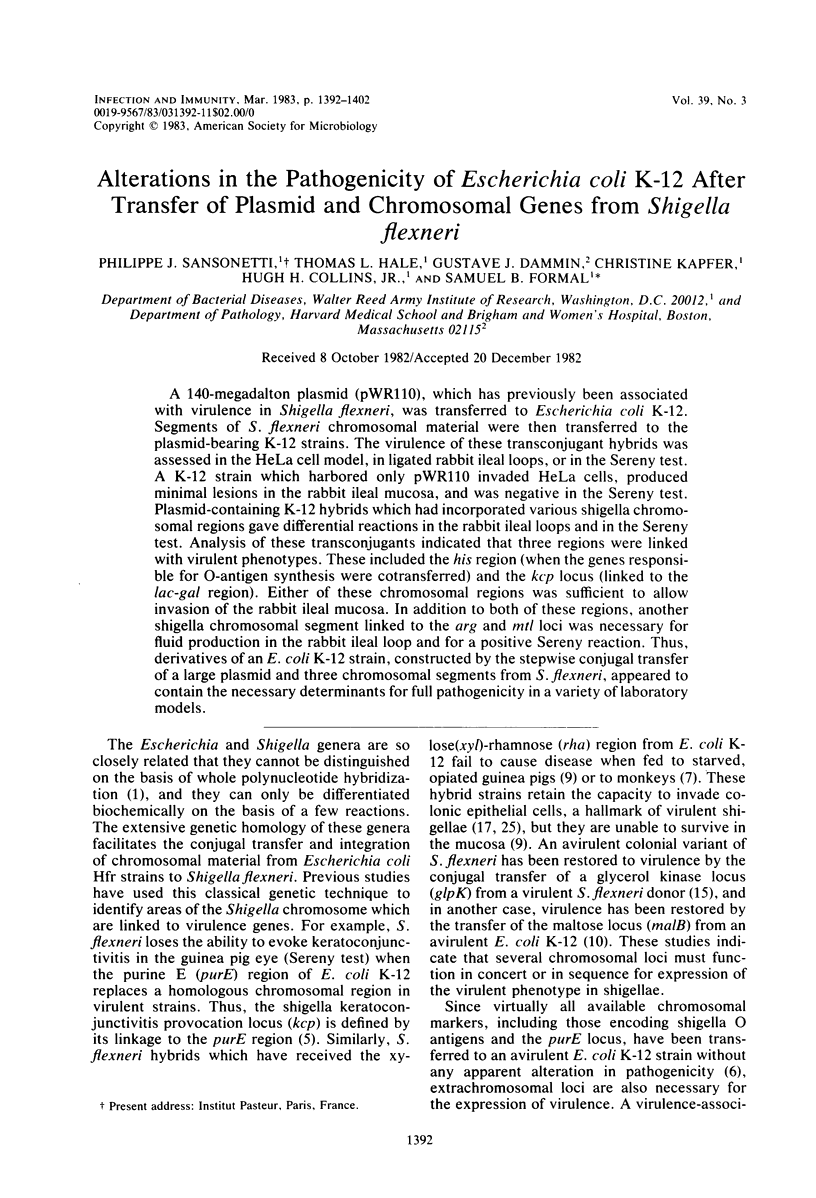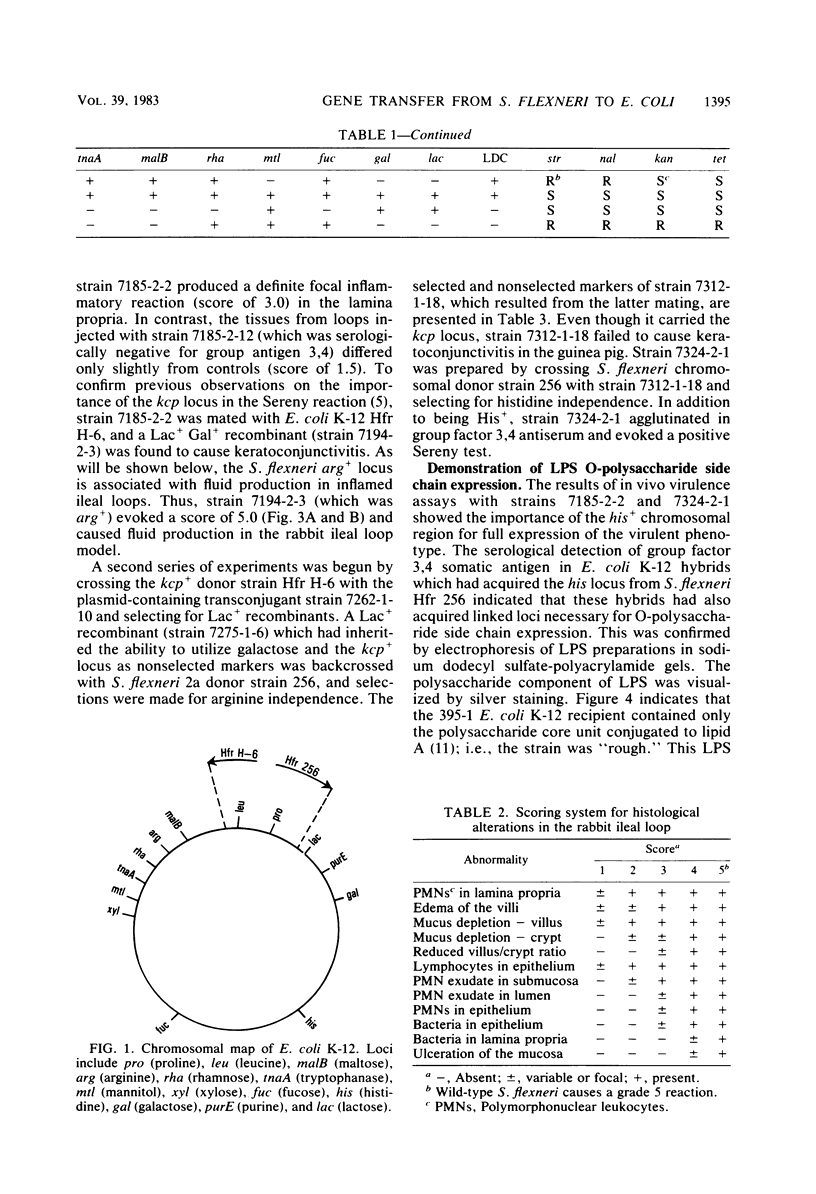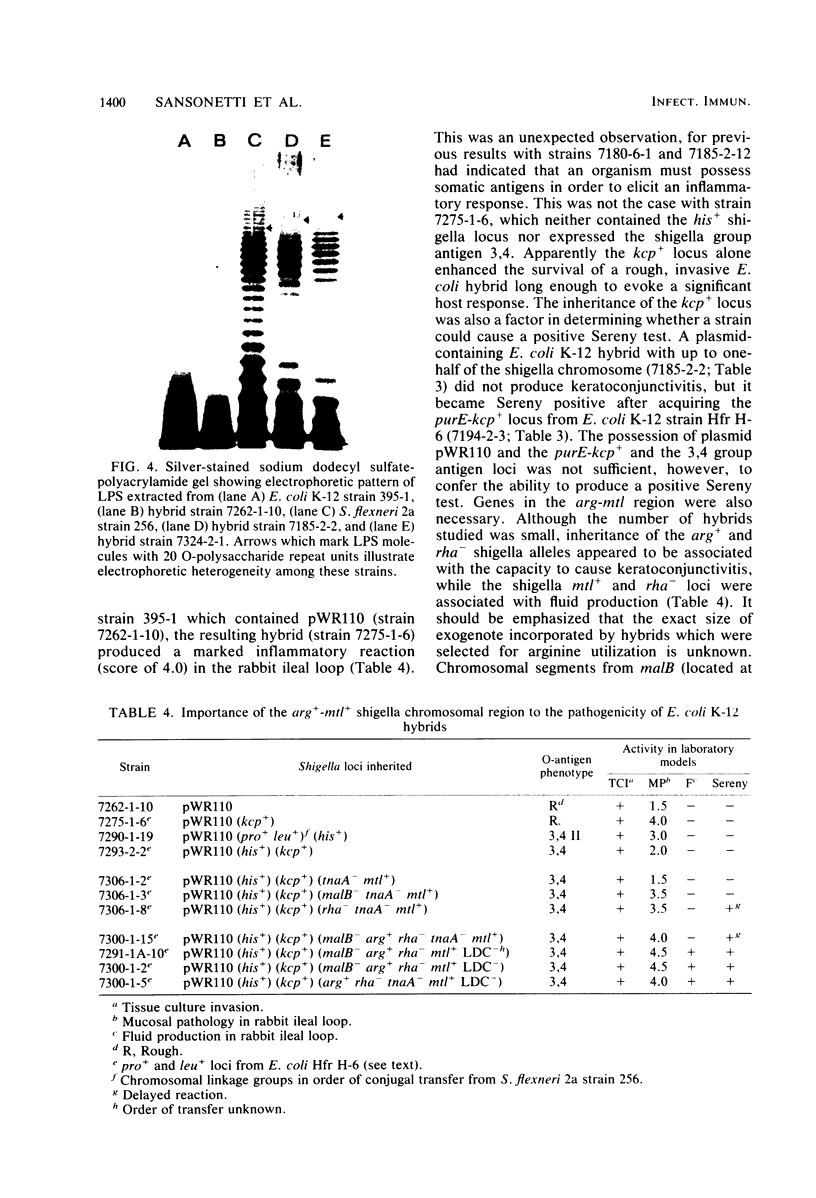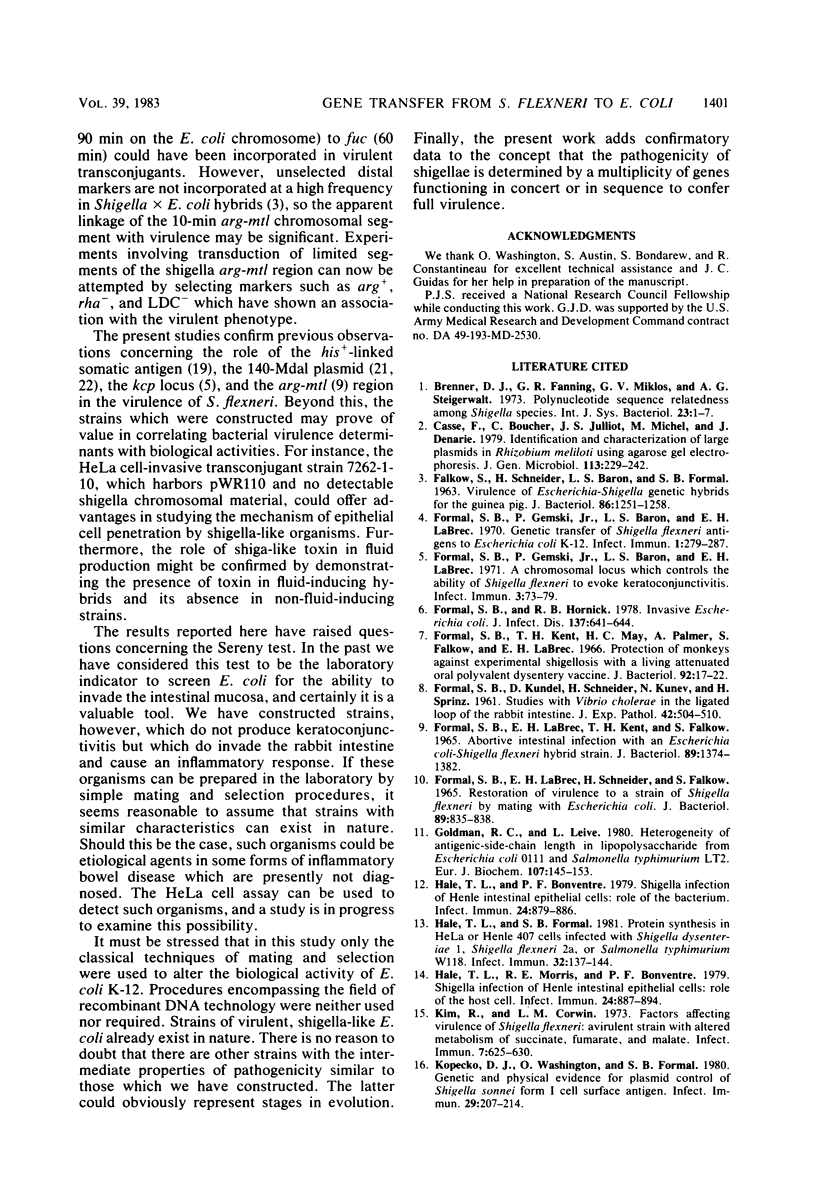Abstract
A 140-megadalton plasmid (pWR110), which has previously been associated with virulence in Shigella flexneri, was transferred to Escherichia coli K-12. Segments of S. flexneri chromosomal material were then transferred to the plamid-bearing K-12 strains. The virulence of these transconjugant hybrids was assessed in the HeLa cell model, in ligated rabbit ileal loops, or in the Sereny test. A K-12 strain which harbored only pWR110 invaded HeLa cells, produced minimal lesions in the rabbit ileal mucosa, and was negative in the Sereny test. Plasmid-containing K-12 hybrids which had incorporated various shigella chromosomal regions gave differential reactions in the rabbit ileal loops and in the Sereny test. Analysis of these transconjugants indicated that three regions were linked with virulent phenotypes. These included the his region (when the genes responsible for O-antigen synthesis were cotransferred) and the kcp locus (linked to the lac-gal region). Either of these chromosomal regions was sufficient to allow invasion of the rabbit ileal mucosa. In addition to both of these regions, another shigella chromosomal segment linked to the arg and mtl loci was necessary for fluid production in the rabbit ileal loop and for a positive Sereny reaction. Thus, derivatives of an E. coli K-12 strain, constructed by the stepwise conjugal transfer of a large plasmid and three chromosomal segments from S. flexneri, appeared to contain the necessary determinants for full pathogenicity in a variety of laboratory models.
Full text
PDF










Images in this article
Selected References
These references are in PubMed. This may not be the complete list of references from this article.
- FALKOW S., SCHNEIDER H., BARON L. S., FORMAL S. B. VIRULENCE OF ESCHERICHIA-SHIGELLA GENETIC HYBRIDS FOR THE GUINEA PIG. J Bacteriol. 1963 Dec;86:1251–1258. doi: 10.1128/jb.86.6.1251-1258.1963. [DOI] [PMC free article] [PubMed] [Google Scholar]
- FORMAL S. B., KUNDEL D., SCHNEIDER H., KUNEVN, SPRINZ H. Studies with Vibrio cholerae in the ligated loop of the rabbit intestine. Br J Exp Pathol. 1961 Oct;42:504–510. [PMC free article] [PubMed] [Google Scholar]
- FORMAL S. B., LABREC E. H., FALKOW S. RESTORATION OF VIRULENCE TO A STRAIN OF SHIGELLA FLEXNERI BY MATING WITH ESCHERICHIA COLI. J Bacteriol. 1965 Mar;89:835–838. doi: 10.1128/jb.89.3.835-838.1965. [DOI] [PMC free article] [PubMed] [Google Scholar]
- FORMAL S. B., LABREC E. H., KENT T. H., FALKOW S. ABORTIVE INTESTINAL INFECTION WITH AN ESCHERICHIA COLI-SHIGELLA FLEXNERI HYBRID STRAIN. J Bacteriol. 1965 May;89:1374–1382. doi: 10.1128/jb.89.5.1374-1382.1965. [DOI] [PMC free article] [PubMed] [Google Scholar]
- Formal S. B., Gemski P., Baron L. S., Labrec E. H. A Chromosomal Locus Which Controls the Ability of Shigella flexneri to Evoke Keratoconjunctivitis. Infect Immun. 1971 Jan;3(1):73–79. doi: 10.1128/iai.3.1.73-79.1971. [DOI] [PMC free article] [PubMed] [Google Scholar]
- Formal S. B., Gemski P., Baron L. S., Labrec E. H. Genetic Transfer of Shigella flexneri Antigens to Escherichia coli K-12. Infect Immun. 1970 Mar;1(3):279–287. doi: 10.1128/iai.1.3.279-287.1970. [DOI] [PMC free article] [PubMed] [Google Scholar]
- Formal S. B., Hornick R. B. Invasive Escherichia coli. J Infect Dis. 1978 May;137(5):641–644. doi: 10.1093/infdis/137.5.641. [DOI] [PubMed] [Google Scholar]
- Formal S. B., Kent T. H., May H. C., Palmer A., Falkow S., LaBrec E. H. Protection of monkeys against experimental shigellosis with a living attenuated oral polyvalent dysentery vaccine. J Bacteriol. 1966 Jul;92(1):17–22. doi: 10.1128/jb.92.1.17-22.1966. [DOI] [PMC free article] [PubMed] [Google Scholar]
- Goldman R. C., Leive L. Heterogeneity of antigenic-side-chain length in lipopolysaccharide from Escherichia coli 0111 and Salmonella typhimurium LT2. Eur J Biochem. 1980;107(1):145–153. doi: 10.1111/j.1432-1033.1980.tb04635.x. [DOI] [PubMed] [Google Scholar]
- Hale T. L., Bonventre P. F. Shigella infection of Henle intestinal epithelial cells: role of the bacterium. Infect Immun. 1979 Jun;24(3):879–886. doi: 10.1128/iai.24.3.879-886.1979. [DOI] [PMC free article] [PubMed] [Google Scholar]
- Hale T. L., Formal S. B. Protein synthesis in HeLa or Henle 407 cells infected with Shigella dysenteriae 1, Shigella flexneri 2a, or Salmonella typhimurium W118. Infect Immun. 1981 Apr;32(1):137–144. doi: 10.1128/iai.32.1.137-144.1981. [DOI] [PMC free article] [PubMed] [Google Scholar]
- Hale T. L., Morris R. E., Bonventre P. F. Shigella infection of henle intestinal epithelial cells: role of the host cell. Infect Immun. 1979 Jun;24(3):887–894. doi: 10.1128/iai.24.3.887-894.1979. [DOI] [PMC free article] [PubMed] [Google Scholar]
- Kim R., Corwin L. M. Factors affecting virulence of Shigella flexneri: avirulent strain with altered metablism of succinate, fumarate, and malate. Infect Immun. 1973 Apr;7(4):625–630. doi: 10.1128/iai.7.4.625-630.1973. [DOI] [PMC free article] [PubMed] [Google Scholar]
- Kopecko D. J., Washington O., Formal S. B. Genetic and physical evidence for plasmid control of Shigella sonnei form I cell surface antigen. Infect Immun. 1980 Jul;29(1):207–214. doi: 10.1128/iai.29.1.207-214.1980. [DOI] [PMC free article] [PubMed] [Google Scholar]
- Labrec E. H., Schneider H., Magnani T. J., Formal S. B. EPITHELIAL CELL PENETRATION AS AN ESSENTIAL STEP IN THE PATHOGENESIS OF BACILLARY DYSENTERY. J Bacteriol. 1964 Nov;88(5):1503–1518. doi: 10.1128/jb.88.5.1503-1518.1964. [DOI] [PMC free article] [PubMed] [Google Scholar]
- Laemmli U. K. Cleavage of structural proteins during the assembly of the head of bacteriophage T4. Nature. 1970 Aug 15;227(5259):680–685. doi: 10.1038/227680a0. [DOI] [PubMed] [Google Scholar]
- Okamura N., Nakaya R. Rough mutant of Shigella flexneri 2a that penetrates tissue culture cells but does not evoke keratoconjunctivitis in guinea pigs. Infect Immun. 1977 Jul;17(1):4–8. doi: 10.1128/iai.17.1.4-8.1977. [DOI] [PMC free article] [PubMed] [Google Scholar]
- Palva E. T., Mäkelä P. H. Lipopolysaccharide heterogeneity in Salmonella typhimurium analyzed by sodium dodecyl sulfate polyacrylamide gel electrophoresis. Eur J Biochem. 1980;107(1):137–143. doi: 10.1111/j.1432-1033.1980.tb04634.x. [DOI] [PubMed] [Google Scholar]
- Sansonetti P. J., Kopecko D. J., Formal S. B. Involvement of a plasmid in the invasive ability of Shigella flexneri. Infect Immun. 1982 Mar;35(3):852–860. doi: 10.1128/iai.35.3.852-860.1982. [DOI] [PMC free article] [PubMed] [Google Scholar]
- Sansonetti P. J., d'Hauteville H., Formal S. B., Toucas M. Plasmid-mediated invasiveness of "Shigella-like" Escherichia coli. Ann Microbiol (Paris) 1982 May-Jun;133(3):351–355. [PubMed] [Google Scholar]
- Simmons D. A. Immunochemistry of Shigella flexneri O-antigens: a study of structural and genetic aspects of the biosynthesis of cell-surface antigens. Bacteriol Rev. 1971 Jun;35(2):117–148. doi: 10.1128/br.35.2.117-148.1971. [DOI] [PMC free article] [PubMed] [Google Scholar]
- Tsai C. M., Frasch C. E. A sensitive silver stain for detecting lipopolysaccharides in polyacrylamide gels. Anal Biochem. 1982 Jan 1;119(1):115–119. doi: 10.1016/0003-2697(82)90673-x. [DOI] [PubMed] [Google Scholar]
- VOINO-IASENETSKII M. V., KHAVKIN T. N. IZUCHENIE VNUTRI'EPITELIAL'NO I LOKALIZATSII VOZBUDITELE I DIZENTERII PRI POMOSHCHI FLUORESTSIRUIUSHCHIKH ANTITEL. Zh Mikrobiol Epidemiol Immunobiol. 1964 Apr;41:98–100. [PubMed] [Google Scholar]





